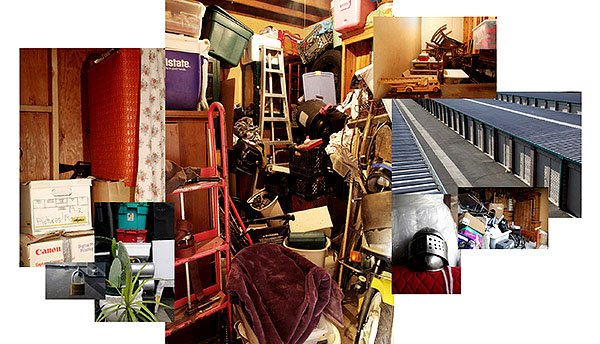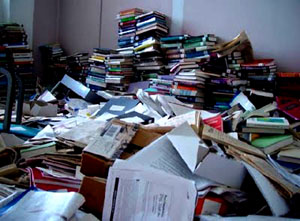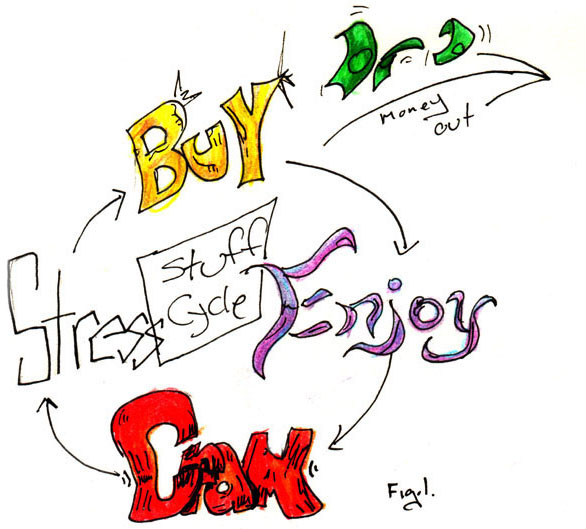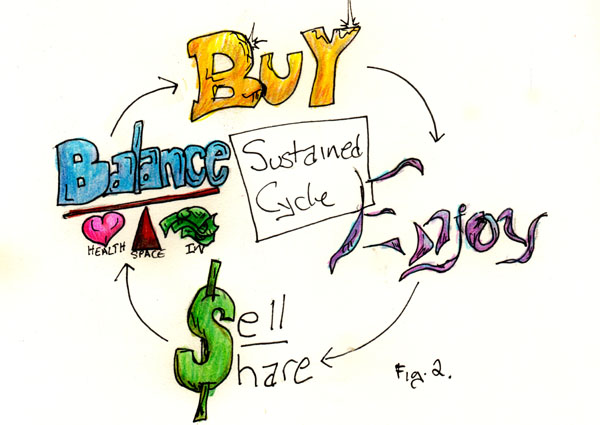Releasing Yourself from Your Stuff
Books, DVDs, Magazines, Comic Books, Kinck-nacks, Tchotchkys, dust-catchers, #@%# clutter everywhere and why can’t I find a single flat surface to put down this coffee mug?! Does this sound like something that runs through your brain when entering your “office,” “den” or your whole house?
Don’t worry; you are simply part of the “great American propensity toward accumulating stuff,” which has been studied by Tom Litton, a Self-Storage industry veteran and Sociology departments around the world. “By the early ’90s, American families had…twice as many possessions as they did 25 years earlier,” according to Juliet B. Schor, Boston College sociologist. “By 2005, the average consumer purchased one new piece of clothing every five and a half days.” (Mooallem, 2009)
My wife and I are no different. The findings of a 2006 U.C.L.A. study particularly hit home. It “found middle-class families in Los Angeles ‘battling a nearly universal over accumulation of goods.’ Garages were clogged. Toys and outdoor furniture collected in the corners of backyards. ‘The home-goods storage crisis has reached almost epic proportions,’ the authors of the study wrote.” (Mooallem, 2009)
I hit a point in November, financially and spatially, when I had to draw the line. I needed extra income for Christmas, and I needed my office closet back. Both of those objectives were reached, but here it is, entering Spring, and I’m still selling stuff. Why? Because I discovered something; I “struck gold” emotionally and metaphorically speaking.
My family—and I posit many American families—are stuck in a negative stuff cycle. We accumulate, enjoy, cram the now-less-fun stuff into some corner of our home, and repeat. This cycle weighs us down financially, organizationally and emotionally—and one of the ways we respond is to buy more stuff. Hence, the Stuff Cycle. (see Fig. 1. above)
This is not an article about how to make money online—although that’s in here. This is an article about breaking the Stuff Cycle and building a healthy cycle which fulfills your finances and your family.
Who Made This Mess?!

“Only in America – do we leave cars worth thousands of dollars in
the driveway and put our useless junk in the garage.”
-Anonymous
“Our stuff has a powerful grip,” says Regina Leeds, author of One Year to an Organized Life, and she’s right, of course. (Grimshaw, 2008) America is fascinated with the show Hoarders because of its depiction of people in the grip of their stuff. Further, some form of that fascination is also due to a self-absolution of our own clutter achieved by watching someone worse than ourselves.
I posit that there is a Clutter Continuum, which goes along with the Stuff Cycle.
Hoarding is “‘a debilitating condition where they accumulate clutter to the point of impairment,’ said Dr. Julie Pike, a psychologist at Anxiety Disorders Treatment Center in Durham, N.C. ‘We estimate 2 million people in the U.S. have this problem, but we can’t be exactly sure because people who hoard are very secretive about it.’” (Doyle, 2010)
Hoarding is on one end of the spectrum. On the other end of the spectrum is the attachment to stuff in which “people turn physical objects into magic talismans that connect them to memories (and) better times in their lives,” and thus have great difficulty letting them go, wrote Regina Leeds. (Grimshaw, 2008) The rest of America is crammed into the middle of the continuum. Don’t fret; there’s plenty of space. The Self Storage Association noted “with more than seven square feet [of storage for sale] for every man, woman and child, it’s now ‘physically possible that every American could stand — all at the same time — under the total canopy of self-storage roofing.’”
The constant consumption of the Stuff Cycle and our American progression up the Clutter Continuum, has birthed an entire industry which provides storage for things that we don’t need to live, but are psychologically gripped by. The self storage industry loves the bind you’re in, according to Derek Naylor, president of Storage Marketing Solutions. “Human laziness has always been a big friend of self-storage operators…as long as [people] feel psychologically that they can afford it, they’ll leave that stuff in there forever.” (Mooallem, 2009)
No matter if you are simply a clutterer or a hoarder, the root cause is the same. Emotional attachment, fast pace of life and Naylor’s accused ‘laziness’ all combine with holding on to something you don’t need “…to avoid the distress of having to make the decision to let go of something,” Dr. Pike said. Elizabeth Robinson, a Denver psychologist, agreed. “I think there is a great fear of making a decision that could be wrong, of feeling something like regret or loss our guilt about getting rid of things.”
Cognitive Consumption
“Your home should be your sanctuary, your buffer against the
world, it is torture if you’re living in chaos.”
-Regina Leeds
 Balancing our buying and storing with sharing and selling has three main benefits; decreased emotional, spatial and financial stress. Take these three examples of the cost of over-consumption.
Balancing our buying and storing with sharing and selling has three main benefits; decreased emotional, spatial and financial stress. Take these three examples of the cost of over-consumption.
Spatial
“The first extreme case of hoarding came to light in 1947,” according to Doyle, “when police found Homer and Langley Collyer dead inside their Fifth Avenue brownstone in Harlem, N.Y. According to the New York Press, Langley Collyer had transformed their house into a fortress with packing boxes and cartons in interlocking tiers with hidden tunnels…He had hoarded so much stuff; the house was starting to buckle under the weight of it all, and Langley was buried alive while trying to bring his brother food.”
Financial
This physical stress on the Collyer house—along with the threat of a crap-a-lanch—also wears on our emotional health and financial decision making ability, according to a Rutgers University study. “In financial decision making,” the study found, “where rational and deliberative thinking is essential, a stressful environment” like a cluttered home or office, can “hamper our ability to make decisions.” The study’s press release asserted that the data may indicate that those of us “feeling extreme unease about the security of our jobs and being able to make our next mortgage payment” need to target environmental stress—like disorganization and clutter—because the decision impairing “stress could make our financial troubles even worse.” (Isanki, 2009)
Emotional
Not only are “guilt, grief and attachment are common motivations for retaining old things well past their expiration date,” but “many professional organizers and psychologists, who often refer clients to each other, believe that clutter can be indicative of underlying psychological issues like…low self-esteem and an inability to make decisions.” This does not mean your messy kitchen table or boxes of Home & Garden indicate that you’ve lost your mind. Rather, it may indicate increased stress, unsettled losses, feeling overwhelmed or impaired ability to make decisions or create order.
“Psychology shapes a person’s relationship to his or her space and stuff,” according to organizational psychologists, but that also means the opposite is also true. You can reduce stress, make sense of your life, and increase your feeling of control and your bank account simply by reducing your clutter.
Soul Sustenance
“Life is a casting off.”
-Linda, Death of a Salesman
 The return of control is found in two things; understanding and balance.
The return of control is found in two things; understanding and balance.
Teri Lynn Mabbitt, a Denver-based professional organizer, uses four categories to help her clients understand the root of their clutter. “Technical: Clutter that causes space restrictions and an overall lack of storage space. Life changes: Clutter caused by a new baby, a death in the family, a move or anything that has thrown a life out of balance. Behavioral/psychological: Clutter caused by depression, attention deficit disorder, low self-esteem or lack of personal boundaries. Time/life management: Clutter caused by the need for better planning.” The greatest value of clutter is that it can reveal things about yourself and your life which need acceptance, addressing or adjustment; that are powerful stuff. (Grimshaw, 2008)
But some of us don’t care what their junk says, they just want it out. I get that. In Figure 2 (below) I’ve mapped out the Sustained Cycle. It is a depiction of how, through replacing storage (or “Cram” in Fig. 1) with a measured amount of Selling or Sharing, we can continue to buy stuff and enjoy life with much less stress, and in fact, reduce our stress. This is achieved when we pull out the items we’ve accumulated and release them to the world with the goal of not just emotional health or reduced clutter or even increased cash flow, but balance. Balance to home-space, balance to the guilt or loss of letting go vs. the stress and weight of holding on and balance to our finances. These are represented by a heart, scale and stack of money under “Balance” in the diagram.
While just a guide, I truly do rate the things that I release on these criteria. Here’s a caution: Never let increased cash flow be the most important. It’ll never happen. For me, less clutter is most important, then emotional health, then financial boost. Thus, if I’ve put an old holiday music box on eBay and someone offers me a price lower than I’ve listed, my first thought isn’t “But, I wanted $35!” it’s “Well, it will get it out of our house, and that’s a gain, We’ll feel more relaxed, that’s a gain and I make $25.” This is a true story which also shows a benefit greater than all of the ones listed; the joy of stuff you don’t need becoming someone else’s treasured possession. That music box was weight passed from my wife’s parents, who never used it, and it sat in our basement for 10 years, unopened. Now it’s half way to California and a new mother of twins seeking to start a new Christmas tradition.
Here are some ideas if you are now eager to jump in and release your clutter to the world:
Create a hierarchy of selling: Sort your stuff into things that you think have monetary value on the Internet, yard sale value, value shared with friends and donation value to Purple Heart or your local thrift store.
Don’t start with eBay or Craigslist: Even though I use both regularly, there are other options. www.SellBackYourBook.com and www.SellDVDsOnline.comare my go-to first stops for books, DVDs and Video Games. Just type in the UPC code and they give you a price. They send you a mailing label when you’re done and your money goes to your PayPal account. So easy. If those two won’t take them, I go to Amazon.com because they have a Trade In department which is similar, if a little more picky, which pays in Amazon gift cards. Finally, check out FaceBook for local “Online Yard sale” groups which usually are organized by county. It’s more informal and specialized, but it connects you with people who want your stuff.
Remember Your Goal: The goal is balancing. Be warned that these sites are more designed to sell you things. If your goal is balance, set a goal to earn a certain amount, or move a certain weight or spatial goal out of your house before buying and bringing new stuff in. I just did that with $100 off a new coffee table amassed in sales of old books, DVDs, Video Games and basement clutter.
It feels great, it’s easy and the power is in your hands once again.
—————————————————————————
Doyle, J. R. (2010, August 13) Under the Clutter: The Psychology Behind Hoarding. FoxNews.com Retrieved From: http://www.foxnews.com/health/2010/08/13/clutter-psychology-hoarding/
Grimshaw, H. (2008, June 5) The Psychology of Clutter The Denver Post. Retrieved from: http://www.denverpost.com/ci_8060057
Isanski, Barbara. Association for Psychological Science. (2009). From Stress to Financial Mess. Retrieved From: http://www.psychologicalscience.org/index.php/news/releases/from-stress-to-financial-mess-study-suggests-acute-stress-affects-financial-decision-making.html
Mooallem, J. (2009, September 2) The Self-Storage Self. New York Times. Retrieved From: http://www.nytimes.com/2009/09/06/magazine/06self-storage-t.html?pagewanted=all&_r=0


